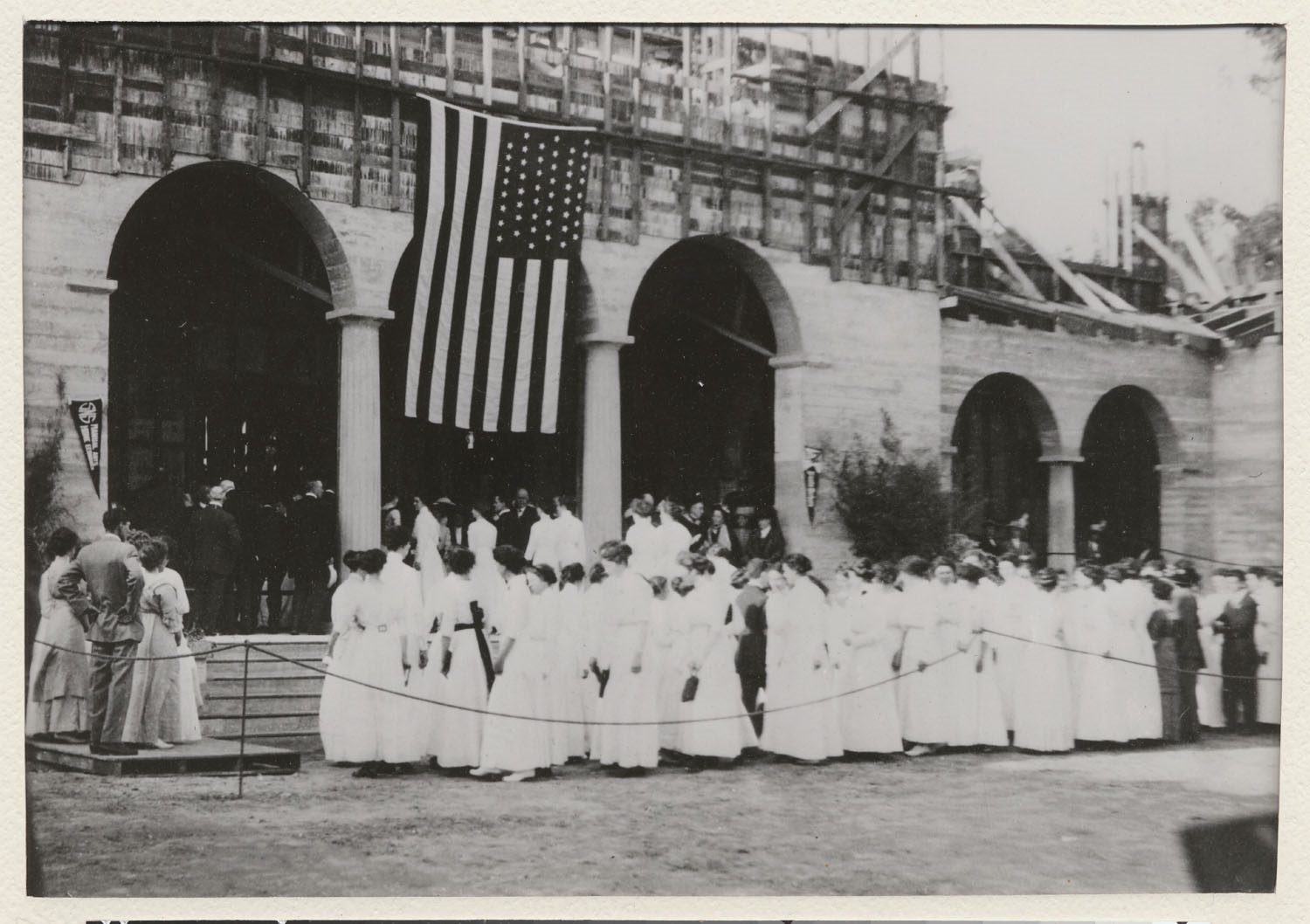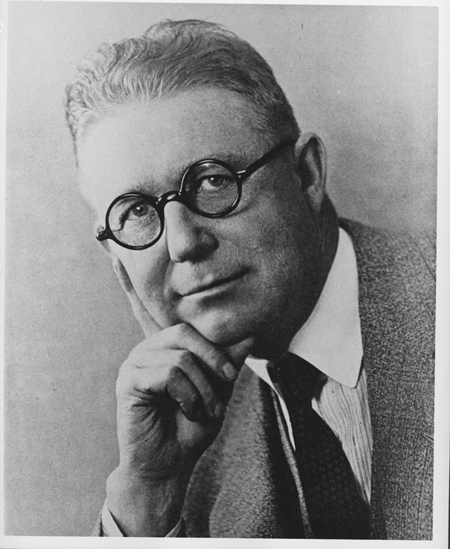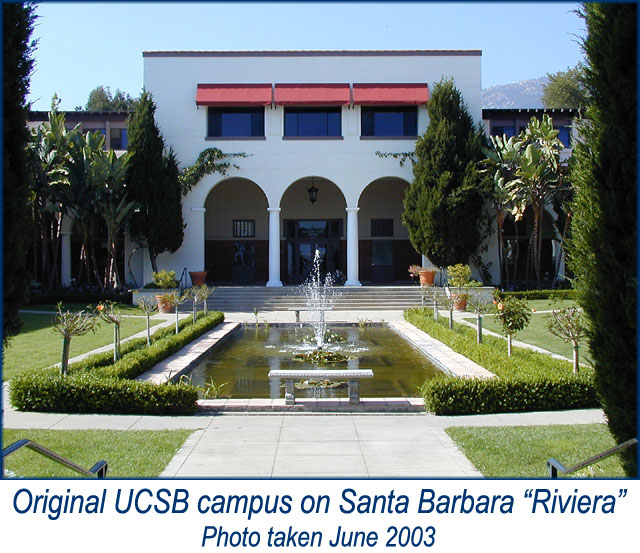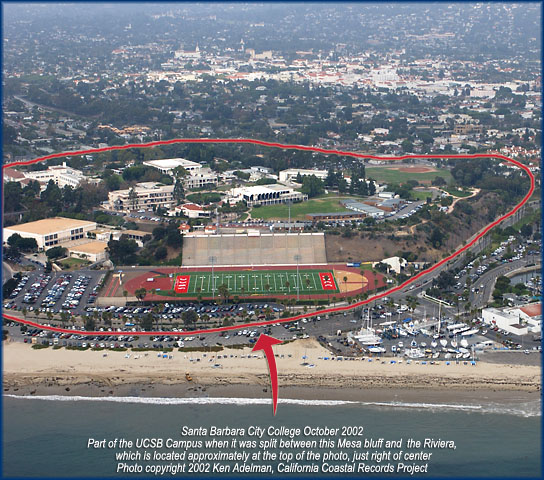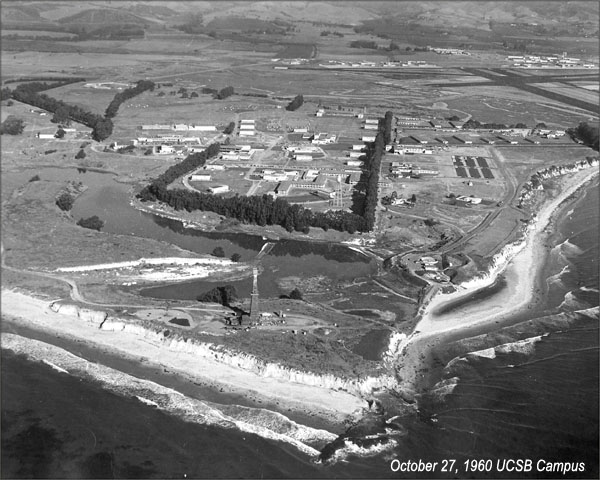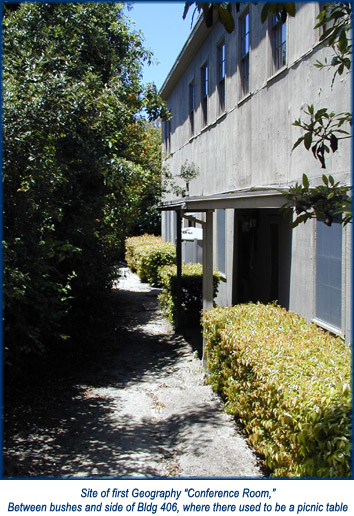UCSB started out as the Anna S.C. Blake School for Girls – a Santa Barbara manual training school which trained teachers at the turn of the 20th century. In 1909, Blake School became the Santa Barbara State Normal School of Manual Arts and Home Economics and offered a 2 year program of courses on teacher training, industrial arts, home economics, and foreign languages. In 1919, its new president, Clarence Phelps, broadened the school’s mission to include the training of all elementary teachers, and the school’s name was changed to Santa Barbara State Normal School. In 1921, it became Santa Barbara State Teachers College and offered a 4 year program, and, in 1935, it began to offer liberal arts degrees, and its name was changed to Santa Barbara State College.
“Intense lobbying by an interest group in the City of Santa Barbara, led by Thomas Storke and Pearl Chase, persuaded the State Legislature, Governor Earl Warren, and the Regents of the University of California to move the State College over to the more research-oriented University of California system in 1944. The State College system sued to stop the takeover, but the Governor did not support the suit. A state initiative was passed, however, to stop subsequent conversions of State Colleges to University of California campuses” [1]. Fall semester enrollment during the first year of operation of the Santa Barbara College of the University of California was 1,464; the school employed a faculty of 95, and Geography classes were offered by faculty in various departments [2].
In 1944, Clarence L. Phelps (1881-1964) was appointed the first Santa Barbara College of the University of California provost when the campus became a part of the University system, retiring from that position in 1946. He died in Santa Barbara on May 7 1964, at the age of 83 [3]. William Henry Ellison, Professor of History, Emeritus, and Doctor of Laws, 1878-1965 “pioneered history instruction at Santa Barbara State College in 1924 and advocated the transfer of the institution from a state college to a University of California campus. That transfer occurred in 1944 when The Santa Barbara College of the University of California was established; at that time, Ellison was named chairman of the Department of Social Sciences, a position which he held until 1946. He became Professor Emeritus in 1948” [4].
In 1954, the College moved from its dual locations of the Riviera and the Mesa in Santa Barbara to the old WWII marine base on Goleta Point, and, in 1958, it was designated a general campus of the UC system and renamed the University of California Santa Barbara [5]. Samuel B. Gould was UCSB’s first Chancellor, 1959-1962.
The UCSB Department of Geography also keeps playing musical chairs in terms of its physical location on the current campus. First, it was housed in a WWII Marine bungalow which it shared with an anatomy lab. Then it moved to Ellison Hall, which it shared with the Departments of History, Sociology, Film and Media Studies, Communication, and Law and Society. Now it hopes to move to Phelps Hall, once the Gevirtz Graduate School of Education moves out of Phelps and into new premises. “While the Department started small and was known for its camaraderie, it has become one of the larger Geography departments in the United States. Approximately 200 undergraduates and 100 graduate students are enrolled. Considering its present size, Theresa Everett, who worked in the Department for 25 years, quipped: ‘We’ve been a victim of our own success. We’ve gotten so big, we don’t have the small-town feel anymore’” [6].
In 1963, “The Geography Program” was housed in “Building 406” – a “temporary” two-story, wood frame bungalow left over from the WWII Marine Base that had become the present UCSB campus in 1954. “The offices, diagonally across the walkway from the Geology Building, were somewhat campy. Walls were thin, colors dingy, electrical outlets minimal, and furnishings well used. The ground floor was occupied by Geography; upstairs was an anatomy lab. If you knew the right person, you could get a tour of the cadaver du jour. Luckily, the smell of formaldehyde didn’t waft downstairs” [7].
The Department of Geography moved into Ellison Hall in 1969, where it has been fighting for more space ever since. In 1998, the External Review Committee for the Program Review Panel concluded that the shortage and fragmentation of physical space was so extreme that it demanded immediate attention. While the university administration agreed to give the resolution of Geography’s space problems a high priority, it wasn’t until 2003 that some of the space issues began to be addressed when the Department of History moved out of Ellison Hall into a newly constructed humanities building and Geography was given most of the History rooms, including what is now its Conference Room. However, the Department remained physically fragmented, with faculty, students, and staff housed in buildings scattered across the campus (Marine Science, Bren Hall, Trailer 942, Phelps Hall, Ellison Hall, North Hall, Chemistry, and the Cloud Lab), as well as rented facilities off-campus for the Ocean Physics Laboratory.
The long range solution to the Department’s space problem revolves around moving most of the Department to Phelps Hall, where it can be under one roof – a move projected in 2007 to take about 3 years. To this end, our administrative offices moved to the first floor (southeast wing) of Ellison Hall in 2007 as a preliminary step to moving to Phelps Hall once it is renovated. But, as the 2007 External Review Committee for the Program Review Panel pointed out, “In view of the long history of geography’s space problem and the many proposed solutions over the years, many geography faculty are justifiably skeptical that the Phelps solution will materialize within the next three years. Significant delay would be highly detrimental to the continued health of the department” [8].
By 2008, it was guesstimated that the move to Phelps would take at least another 5 years – and the recent California budget crisis makes even that prediction seem optimistic. However, the department’s spatial problems are being addressed, slowly but surely, as evidenced by the acquisition and renovation of new space in Phelps and Ellison Halls and the move of Tommy Dickey’s off-campus Ocean Physics Lab to Ellison Hall. One spatial step at a time…
Footnotes:
- http://en.wikipedia.org/wiki/University_of_California,_Santa_Barbara
- https://legacy.geog.ucsb.edu/history/timeline/
https://legacy.geog.ucsb.edu/history/a-lively-chronicle/department-growth.html
- https://legacy.geog.ucsb.edu/history/a-lively-chronicle/barely-there.html
- Hanson, S., MacDonald, G., & Townshend, J. (February 2007). Report of the External Review Committee on the Department of Geography, UCSB.
Article by Bill Norrington

